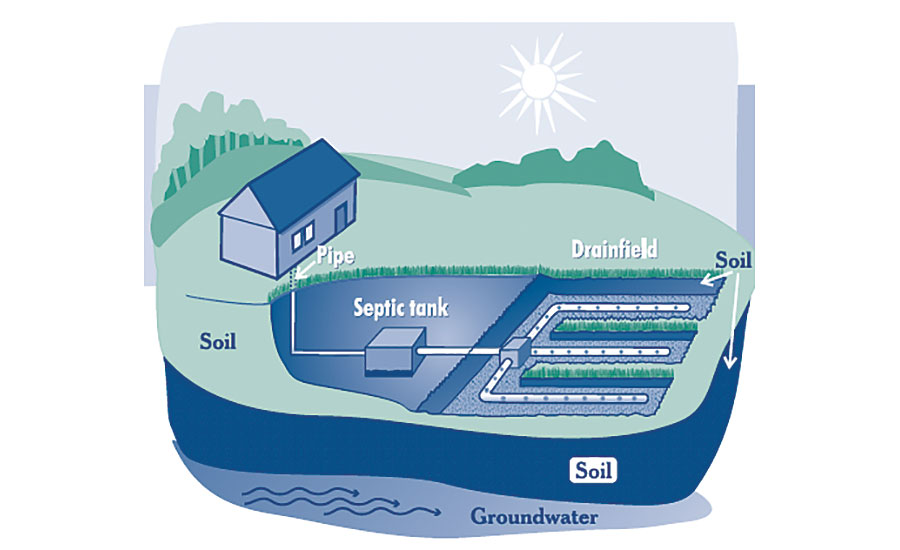Are disposers suitable for septic systems?






Overview
Food waste disposers are installed in more than 60 million homes in the U.S. Most homes are connected to centralized sewage collection and treatment systems, but many use an onsite sewage treatment system, known as a septic system.
The U.S. Environmental Protection Agency estimates 20% of U.S.¹ homes are on septic systems and 10-20% fail every year.² These failures potentially threaten public health and groundwater quality, so the EPA, local authorities having jurisdiction, and other organizations offer advice to prevent failures. This advice includes cautioning homeowners about using food waste disposers, some suggesting that homeowners eliminate or limit the use of a disposer.³ According to one report, no single organization collects data to evaluate the extent of failures.
Based on information available from the National Onsite Wastewater Recycling Association and the National Environmental Services Center at West Virginia University, no data exists implicating food waste disposers for septic system failure.
Background
Septic systems are essentially comprised of two components installed in series – 1) a solids holding tank and 2) a drain field. As wastewater flows into the tank, solid and particulate matter settles out, and the remaining water and soluble organic material flows into the drain field where it slowly leaches into the groundwater through perforated piping spread over a large area. About half the organic material remains in the solids holding tank where it continues to break down, but eventually the solids must be removed by a pumper. The wastewater entering the drain field flows over biofilms growing on the surface of the pipes and undergoes biological decomposition.
See Figure 1 (above) for a Typical Septic System. See Figure 2 (above) for a Septic Tank.
Septic systems may fail for various reasons. The main culprit is improper design and maintenance. Some systems go without maintenance until it is too late and needs to be overhauled. If septic systems are properly designed and maintained, will food waste disposers overload the tank or drain field?
According to the 2013 U.S. American Housing Survey, six million homes on septic systems have a food waste disposer in the kitchen. More than five million of these disposers were manufactured by InSinkErator (based on internal estimates) and no homeowner has lodged a complaint or claim that their disposer caused a septic system failure.
No data exists to support the notion that disposer use leads to increased maintenance and septic system failure.
Organic Load
Disposer use does add organic material to wastewater. This incremental amount is best measured as Total Suspended Solids (TSS) and Biochemical Oxygen Demand (BOD). Table 2 (see page 106 in our digital edition) quantifies the concentration BOD and TSS of septic tank effluent which enters the drain field. It shows the incremental load of BOD and TSS from disposers is nominal, with or without an effluent filter.
Degradation of Organic Matter
Officials are concerned that food waste does not break down in the tank. However, food waste is readily converted to methane during anaerobic digestion with sewage solids at wastewater treatment plants. Septic tanks are unheated and unmixed anaerobic digesters. Even though septic tanks are slightly cooler than anaerobic digesters,5 decomposition of organic matter still occurs, just at a slightly slower rate.
State Regulations for Food Waste Disposers
Only 12 states require designs for septic systems to include the additional loading from kitchen appliances.
California Building Standards dictate systems be designed to accommodate solids loading from disposals, but do not specify the incremental requirement. Some states (CT, KY, NE and RI) specify increasing tank size while others (GA, IL, ME, MA and MN) specify increasing the tank volume from 30-200%. In New York state, the health department stipulates increasing the capacity to that of an additional bedroom.
In Conclusion
Given that state requirements for increased tank volume and drain field size are at least as much as the incremental loading quantified by wastewater professionals, it is reasonable to state that as long as a septic system is properly designed, sized and maintained, the use of a disposer is appropriate for a septic system.
¹ American Housing Survey. 2013. http://www.census.gov/programs-surveys/ahs/data/2013/ahs-2013-summary-tables/national-summary-report-and-tables---ahs-2013.html.
² http://water.epa.gov/infrastructure/septic/
³ http://www.epa.gov/sites/production/files/2015-06/documents/septicsmart-week-flyer091113.pdf
4Wood, Yvonne A. and Brad D. Lee. “Septic System Failure.” http://www.ucanr.org/sites/ceinyo-mono/files/111944.pdf. Accessed 2/9/2016.
5Crites, Ron and George Tchobanoglous. 1998.“Small and Decentralized Wastewater Management Systems.” WCB/McGraw-Hill. p. 314.
Looking for a reprint of this article?
From high-res PDFs to custom plaques, order your copy today!










